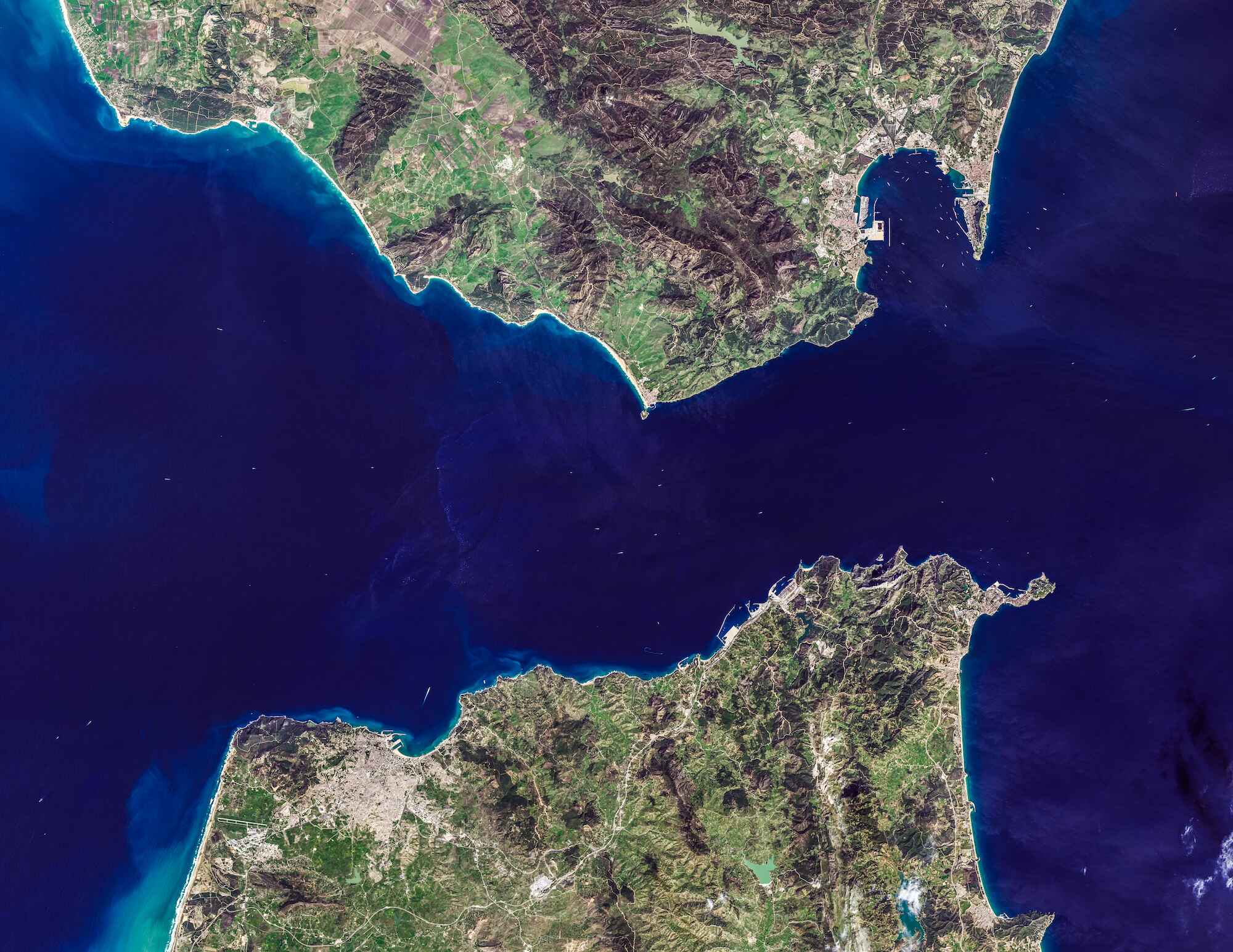
Strait, a narrow passage of water connecting two larger bodies, is not only a fascinating geographical feature but also plays a crucial role in shaping the landscapes and economies of various regions. From strategic trade routes to unique ecosystems, straits have captured the imagination of explorers, adventurers, and scientists alike. In this article, we will uncover nine astounding facts about straits that will leave you captivated and awe-inspired. Get ready to dive into a world of geographic wonders and discover the hidden secrets of these narrow waterways. From the iconic Strait of Gibraltar to the mystical Bosporus Strait, let’s unravel the mysteries of these natural marvels and gain a deeper appreciation for the interconnectedness of our planet’s diverse landscapes.
Key Takeaways:
- The Strait of Gibraltar is a narrow waterway connecting the Atlantic Ocean and the Mediterranean Sea, known for its rich history, diverse marine life, and thrilling water sports activities.
- Named after the iconic Rock of Gibraltar, the strait is a crucial shipping route, a hotspot for cultural exchange, and a source of inspiration for myths and legends.
The Strait of Gibraltar connects the Atlantic Ocean to the Mediterranean Sea.
The Strait of Gibraltar is a narrow waterway that separates the Iberian Peninsula (Spain and Portugal) from the African continent. This strategically significant strait is only 14.4 kilometers wide at its narrowest point, making it a crucial gateway for maritime trade and migration.
It is named after the Rock of Gibraltar.
The name “Strait of Gibraltar” is derived from the iconic Rock of Gibraltar. This massive limestone rock formation rises 426 meters above sea level and has played a significant role in the region’s history, serving as a natural landmark for sailors and a symbol of strength and sovereignty.
The Mediterranean and Atlantic tides meet at the Strait of Gibraltar.
One of the most fascinating natural phenomena at the Strait of Gibraltar is the convergence of the tides from the Mediterranean Sea and the Atlantic Ocean. This meeting point creates powerful currents and can lead to dramatic tidal changes, making navigation through the strait challenging.
The strait is home to diverse marine life, including dolphins and whales.
The nutrient-rich waters of the Strait of Gibraltar support a wide array of marine life. It serves as a vital migratory route for various species, including dolphins and whales. These magnificent creatures can often be spotted by lucky onlookers as they swim through the strait’s waters.
The Strait of Gibraltar has a rich historical and cultural significance.
Throughout history, the Strait of Gibraltar has been a hotspot for trade, exploration, and conquest. It has witnessed the rise and fall of empires, the passage of legendary explorers like Christopher Columbus, and the crossing of armies and cultures. The strait holds immense historical and cultural value.
The Strait of Gibraltar is a crucial shipping route.
As a link between the Atlantic Ocean and the Mediterranean Sea, the Strait of Gibraltar serves as a major shipping route for goods traveling between Europe, Africa, and the Americas. It facilitates international trade and contributes significantly to global commerce.
The strait is a popular destination for thrill-seeking water sports enthusiasts.
The unique combination of strong currents and favorable wind conditions makes the Strait of Gibraltar a magnet for adrenaline junkies seeking adventure. Water sports like windsurfing, kiteboarding, and sailing are popular activities in the area.
There is a ferry service that connects Europe and Africa through the strait.
The geographical proximity of Europe and Africa at the Strait of Gibraltar has led to the establishment of a ferry service between the two continents. This convenient mode of transportation allows travelers to experience a seamless journey between the two continents, providing a fascinating cultural exchange.
The Strait of Gibraltar has inspired myths and legends.
Throughout history, the Strait of Gibraltar has sparked the imagination of many, giving rise to numerous myths and legends. From tales of mythical creatures dwelling in its depths to stories of heroes and gods crossing its waters, the strait has a mystical allure that continues to captivate.
Conclusion
In conclusion, the strait is a fascinating geographical feature that holds many surprises and wonders. From its role in shaping maritime trade and transportation to being a natural barrier between land masses, straits play a crucial role in our world. The nine astounding facts about straits highlight their significance and the impact they have on various aspects of human life.Whether it is the geological processes that form them, the diverse marine ecosystems they support, or the historical significance they hold, straits are truly remarkable natural wonders. Exploring these unique water channels can provide valuable insights into the forces that shape our planet.Next time you come across a strait on a map or hear about it in a conversation, remember the incredible stories and astonishing facts that these narrow passages have to offer. It’s a reminder of just how diverse and awe-inspiring our planet can be.
FAQs
Q: What is a strait?
A: A strait is a narrow waterway that connects two larger bodies of water, typically separating two land masses. It acts as a natural channel for maritime transportation and shipping.
Q: How are straits formed?
A: Straits are often formed by geological processes such as erosion, tectonic activity, or the rising and falling of sea levels. For example, a strait can be created when two land masses gradually pull apart, leaving a narrow passage of water in between.
Q: What is the significance of straits?
A: Straits have immense economic importance as they serve as major trade routes and gateways for international commerce. They also play a crucial role in military strategies and act as natural barriers between nations.
Q: Are straits home to unique ecosystems?
A: Yes, straits often support diverse marine ecosystems due to their unique combination of strong currents, fluctuating water temperatures, and varying depths. These ecosystems can be home to a wide range of plant and animal species.
Q: Can straits have historical significance?
A: Absolutely! Many straits have played pivotal roles in historical events, serving as important locations for battles, trade expeditions, and cultural exchanges between civilizations.
Q: What are some famous straits?
A: Some well-known straits include the Strait of Gibraltar, which connects the Atlantic Ocean to the Mediterranean Sea, and the Strait of Hormuz, a crucial passage for global oil transportation located between the Persian Gulf and the Gulf of Oman.
Q: Are there any dangers associated with navigating through straits?
A: Yes, straits can present challenges for maritime navigation due to strong currents, narrow passages, and potential congestion from high shipping traffic. Proper navigational skills and awareness are important for safe passage.
Q: Can straits change over time?
A: Yes, straits can change due to natural processes or human intervention. For example, coastal erosion or sediment deposition can alter the width or depth of a strait, affecting its navigability.
Q: Are there any famous landmarks located near straits?
A: Yes, many straits are surrounded by iconic landmarks such as historic lighthouses, forts, or scenic viewpoints that offer breathtaking views of the surrounding waterways and landscapes.
Unraveling secrets of straits doesn't stop here! Delve into George Strait's incredible life story, from humble beginnings to country music stardom. Marvel at Melaka Straits Mosque's stunning architecture and cultural significance. Explore Torres Strait Reefs' vibrant underwater world, teeming with colorful marine life. Each destination holds unique wonders waiting to be discovered. Whether you're a music aficionado, history buff, or nature lover, there's something captivating for everyone. Join us on this exciting journey as we continue to reveal astonishing facts about some of the world's most fascinating places!
Was this page helpful?
Our commitment to delivering trustworthy and engaging content is at the heart of what we do. Each fact on our site is contributed by real users like you, bringing a wealth of diverse insights and information. To ensure the highest standards of accuracy and reliability, our dedicated editors meticulously review each submission. This process guarantees that the facts we share are not only fascinating but also credible. Trust in our commitment to quality and authenticity as you explore and learn with us.


